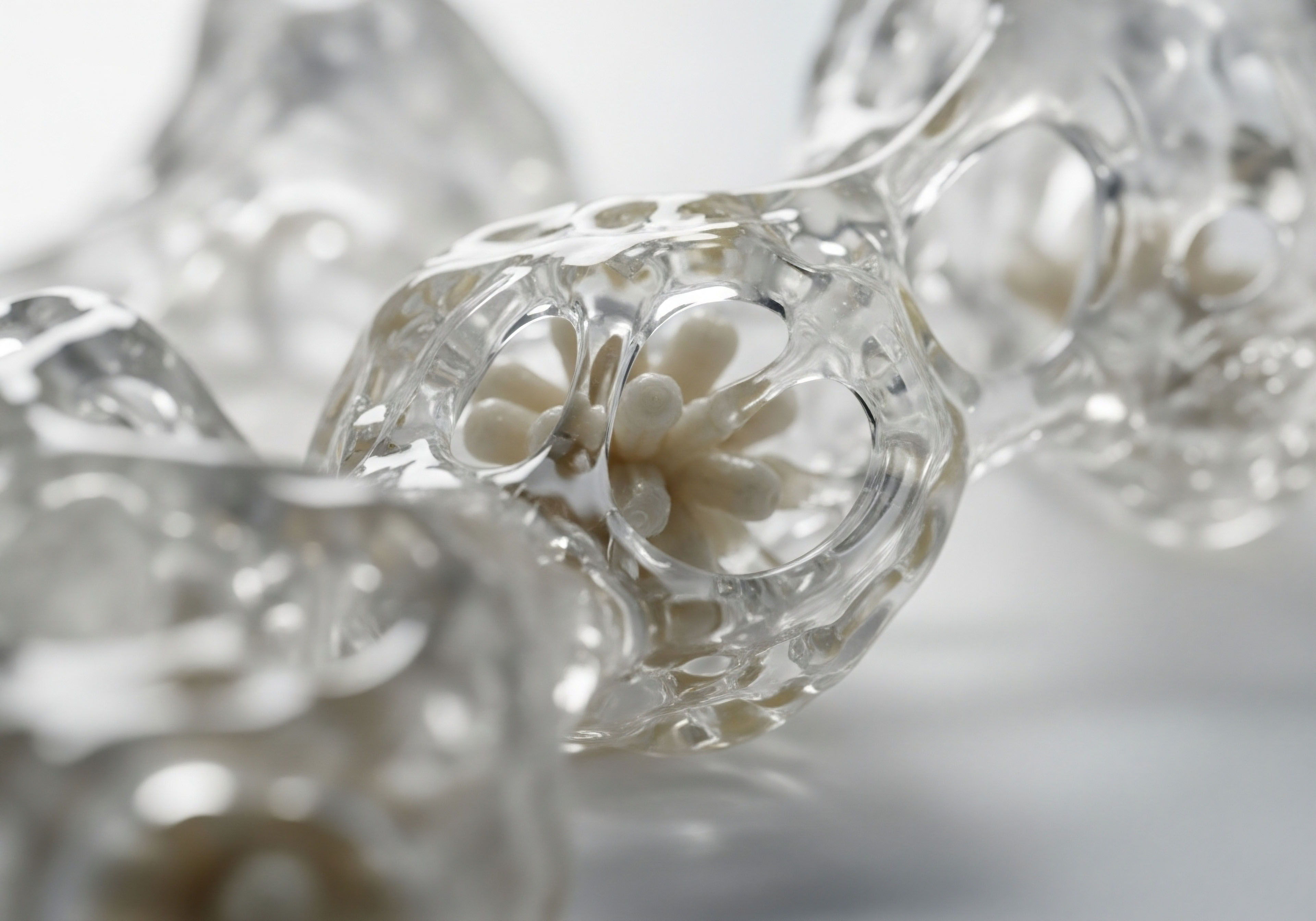

Fundamentals
The feeling is a familiar one for many as the years advance. It manifests as a subtle loss of stamina during a walk, a longer recovery time after exercise, or a general sense that the body’s internal engine is running with less efficiency.
This lived experience of declining vitality is deeply personal, yet it is rooted in a universal biological process. Much of this sensation can be traced back to the health of a vast, intricate, and often overlooked organ system ∞ the vascular endothelium.
Your endothelium is the thin layer of cells lining the interior surface of all blood vessels, from the aorta to the smallest capillaries. It forms a dynamic interface between your blood and your body’s tissues, orchestrating a continuous dialogue that governs circulatory health. Its proper function is central to life itself.
Imagine this cellular lining as a highly intelligent, responsive gatekeeper. In a state of health, it actively manages blood flow, releasing molecules like nitric oxide (NO) to signal the surrounding smooth muscle to relax. This relaxation widens the vessel, a process called vasodilation, which lowers blood pressure and ensures that oxygen and nutrients are delivered efficiently to every cell in your body.
The endothelium also produces substances that prevent blood from clotting inappropriately and manages the traffic of inflammatory cells, permitting them entry into tissues only when necessary for healing. This state of responsive, protective activity is the hallmark of a youthful cardiovascular system. It is the biological foundation for the feeling of vigor and resilience.
The age-related decline in physical stamina is often biologically linked to the diminishing functional capacity of the vascular endothelium.
With the progression of aging, this finely tuned system begins to lose its precision. The condition known as endothelial dysfunction sets in. This involves a reduced capacity of the endothelial cells to produce the vital signaling molecule, nitric oxide.
The blood vessels become less responsive, losing their ability to dilate effectively when the body demands more blood flow, such as during physical exertion. The surface of the endothelium may become more prone to inflammation and the formation of tiny blood clots.
This functional decline is a key event in the development of cardiovascular disease and contributes directly to the palpable symptoms of aging. The stiffness in your joints, the fog in your mind, and the fatigue in your muscles are all connected to how well your circulatory system is delivering life-sustaining resources. Understanding this process is the first step toward addressing it.

The Language of the Body Peptides as Messengers
Within this complex biological landscape, the body communicates with itself using a language of molecular signals. Peptides are a fundamental part of this vocabulary. These are short chains of amino acids, the same building blocks that form larger proteins. Think of them as concise, highly specific messages sent from one part of the body to another to issue a command.
A peptide might instruct a cell to begin repair, to produce a hormone, or to reduce inflammation. Their small size allows them to interact with cellular receptors with high precision, initiating a cascade of downstream effects. The endocrine system, for example, relies heavily on peptide hormones to regulate everything from metabolism to growth.
The body’s innate production of these crucial signaling peptides can wane over time. This reduction in signaling traffic contributes to the slowdown of restorative processes that maintain youthful function. Peptide therapy is a clinical approach designed to supplement or mimic these natural biological messages.
By introducing specific, bioidentical peptides into the system, the goal is to restore the body’s internal communication network. This approach works with the body’s own physiological pathways, aiming to recalibrate systems that have become less efficient with age. In the context of endothelial health, certain peptides have demonstrated a capacity to directly support the function of this critical vascular lining, offering a targeted mechanism for improving circulatory performance and reclaiming a measure of metabolic vitality.


Intermediate
Advancing from a foundational knowledge of endothelial function, we can examine the specific mechanisms through which peptide therapies can instigate meaningful improvements. These protocols are designed to interact with and modulate the precise biological pathways that govern vascular health.
The primary objective is to counteract the age-related decline in nitric oxide bioavailability and mitigate the impacts of oxidative stress, thereby restoring the endothelium’s ability to regulate blood flow and inflammation. Two classes of peptides are particularly relevant in this context ∞ specialized tissue-repair peptides and growth hormone secretagogues.
Each peptide possesses a unique mechanism of action, interacting with different cellular receptors and signaling cascades. This specificity allows for a targeted approach to wellness, addressing distinct aspects of endothelial dysfunction. The selection of a particular peptide protocol is dependent on a comprehensive evaluation of an individual’s unique physiology, symptoms, and health objectives. Understanding how these molecules work provides a clear rationale for their application in age management and wellness protocols.

BPC 157 Restoring the Endothelial Foundation
Body Protective Compound 157, or BPC-157, is a synthetic peptide composed of 15 amino acids, derived from a protein found naturally in stomach acid. Its primary recognized function is promoting rapid tissue healing and regeneration. One of its most significant effects is on the vascular system, where it directly supports endothelial integrity and function.
BPC-157 has been shown in preclinical studies to promote angiogenesis, the formation of new blood vessels from pre-existing ones. This process is vital for healing damaged tissue and for bypassing circulatory blockages. It achieves this, in part, by upregulating the expression of Vascular Endothelial Growth Factor (VEGF), a key signaling protein that stimulates the growth and proliferation of endothelial cells.
The core of BPC-157’s benefit to the endothelium lies in its profound influence on the nitric oxide (NO) system. Research demonstrates that BPC-157 can protect endothelial cells from various forms of damage and can counteract the effects of substances that block NO synthesis.
It appears to modulate the activity of endothelial nitric oxide synthase (eNOS), the enzyme responsible for producing NO within the endothelial cells. By maintaining or increasing eNOS activity, BPC-157 ensures the continued production of this critical vasodilator, promoting healthy blood flow and blood pressure regulation. This direct action on the NO pathway makes it a powerful agent for addressing the central cause of age-related endothelial dysfunction.
Peptide protocols are designed to re-establish the body’s innate signaling pathways that support vascular health and metabolic efficiency.
The applications of BPC-157 extend to protecting the vascular system during periods of stress. It has shown an ability to maintain endothelial integrity in the face of challenges like high blood sugar or exposure to toxins. Its systemic effects on healing mean that it supports the repair of blood vessels throughout the body, contributing to overall cardiovascular resilience. The administration of BPC-157, typically via subcutaneous injection, is aimed at providing a consistent signal for vascular repair and maintenance.
- Mechanism of Action ∞ BPC-157 primarily functions by modulating the nitric oxide pathway and upregulating growth factors like VEGF to promote blood vessel repair and formation.
- Primary Benefit ∞ Its main advantage is the direct stimulation of angiogenesis and the protection of endothelial cells, which is fundamental for tissue healing and circulatory health.
- Administration Route ∞ The most common method for systemic effects is subcutaneous injection, although oral formulations exist for targeted gastrointestinal repair.
- Clinical Application ∞ It is often utilized in protocols for injury recovery, gut health, and as a foundational agent for systemic repair, including the vascular system.

Growth Hormone Secretagogues and Vascular Vitality
Another category of peptides that profoundly impacts endothelial function includes the growth hormone secretagogues (GHS). This group consists of molecules like Sermorelin, CJC-1295, and Ipamorelin. These peptides function as Growth Hormone-Releasing Hormone (GHRH) analogs or ghrelin mimetics. They work by stimulating the pituitary gland to produce and release the body’s own growth hormone (GH).
This is a crucial distinction from administering synthetic GH directly; these peptides honor the body’s natural, pulsatile release of GH, which is associated with a more favorable safety profile.
The connection to endothelial health is mediated through the downstream effects of growth hormone and its primary mediator, Insulin-like Growth Factor 1 (IGF-1). Both GH and IGF-1 have receptors on endothelial cells and play a significant role in maintaining vascular homeostasis.
Studies on adults with growth hormone deficiency (GHD) show that this condition is associated with marked endothelial dysfunction, increased arterial stiffness, and a higher risk of cardiovascular events. Conversely, growth hormone replacement therapy in these individuals has been demonstrated to reverse these issues, improving nitric oxide availability, reducing markers of inflammation, and restoring endothelial-dependent vasodilation.
By stimulating the natural production of GH, peptides like Sermorelin and CJC-1295 can replicate these benefits. Increased circulating levels of GH and IGF-1 help to mobilize endothelial progenitor cells (EPCs) from the bone marrow. These EPCs are critical for repairing damaged endothelium and replacing aged, dysfunctional cells, a process essential for maintaining a healthy vascular lining.
The improved GH/IGF-1 axis also contributes to a more favorable lipid profile, reduced visceral fat, and enhanced lean muscle mass, all of which indirectly support cardiovascular health.

Comparing Common Growth Hormone Peptides
While different growth hormone secretagogues share the same ultimate goal, they have different properties, particularly regarding their half-life and mechanism of action. This allows for the tailoring of protocols to an individual’s specific needs.
| Peptide | Mechanism of Action | Half-Life | Primary Clinical Application |
|---|---|---|---|
| Sermorelin | GHRH analog; stimulates the pituitary gland directly. | Very short (minutes). Requires daily or nightly administration to mimic natural GH pulses. | Used to restore a more youthful pattern of GH release, improving sleep and recovery. |
| CJC-1295 (with DAC) | Long-acting GHRH analog. Drug Affinity Complex (DAC) allows it to bind to plasma proteins. | Long (several days). Provides a sustained elevation of GH and IGF-1 levels. | Applied for more profound and sustained effects on body composition and repair. |
| Ipamorelin | Ghrelin mimetic (a GHS); stimulates GH release with high specificity. | Short (about 2 hours). It does not significantly impact cortisol or prolactin. | Often combined with a GHRH like CJC-1295 to create a powerful, synergistic GH pulse. |
The combination of CJC-1295 and Ipamorelin is a common protocol. CJC-1295 provides a steady elevation in baseline GH levels, while the addition of Ipamorelin creates a strong, clean pulse of GH release, closely mimicking the body’s natural rhythms but with a greater amplitude. This synergistic approach can lead to significant improvements in tissue repair, metabolic function, and, consequently, endothelial health, without the desensitization that can occur with continuous stimulation.


Academic
A sophisticated examination of peptide therapies on endothelial function requires a descent into the molecular mechanisms governing vascular biology. The conversation moves from the organ level to the intricate signaling pathways within the endothelial cell itself. The efficacy of these therapeutic peptides is predicated on their ability to modulate specific enzymatic activities and gene expression programs that are fundamental to vascular homeostasis.
The age-related decline in endothelial function is not a passive process of wear and tear; it is an active biological shift characterized by increased oxidative stress, chronic low-grade inflammation, and a resultant decrease in nitric oxide (NO) bioavailability. Therapeutic peptides intervene directly in these processes.
The central enzyme in this context is endothelial nitric oxide synthase (eNOS). In healthy endothelial cells, eNOS synthesizes NO from the amino acid L-arginine. This NO then diffuses to adjacent vascular smooth muscle cells, activating soluble guanylate cyclase, leading to cGMP production and subsequent vasodilation.
In aging and pathological states, eNOS activity can become “uncoupled.” This means the enzyme, often due to a lack of co-factors like tetrahydrobiopterin (BH4) or increased oxidative stress, produces superoxide radicals instead of NO. This uncoupling not only reduces vasodilation but also actively contributes to vascular damage. Advanced peptide strategies work to prevent this uncoupling and enhance productive eNOS signaling.

The Src-Caveolin-1-eNOS Pathway a Target for BPC 157
The peptide BPC-157 exerts its potent pro-endothelial effects through a highly specific and elegant molecular pathway. Research has elucidated its role in modulating the Src-Caveolin-1-eNOS signaling axis. Caveolin-1 (Cav-1) is a structural protein within endothelial cell membrane invaginations called caveolae. In a resting state, Cav-1 is bound to eNOS, holding it in an inactive conformation. The activation of eNOS requires its dissociation from this inhibitory binding. This is where the signaling cascade begins.
Studies demonstrate that BPC-157 induces the phosphorylation of the Src kinase. Src is a non-receptor tyrosine kinase that, once activated, phosphorylates other proteins. Activated Src, in turn, phosphorylates Caveolin-1. This phosphorylation of Cav-1 is the critical step that causes it to release eNOS.
Once liberated from Cav-1, eNOS is free to be phosphorylated and activated by other kinases, such as Akt, leading to a robust production of nitric oxide. A 2020 study in the Journal of Physiology and Pharmacology confirmed that BPC-157’s vasodilatory effect was NO-mediated and that it enhanced the phosphorylation of Src, Cav-1, and eNOS.
The use of a Src inhibitor abolished these effects, confirming the upstream role of Src in this BPC-157-induced pathway. This detailed mechanistic understanding elevates BPC-157 from a general “healing peptide” to a specific modulator of a key vascular regulatory pathway.
Therapeutic peptides can directly modulate the enzymatic machinery within endothelial cells to restore nitric oxide production and combat oxidative stress.
Furthermore, BPC-157’s influence extends to the expression of genes critical for vascular health. It upregulates Vascular Endothelial Growth Factor Receptor 2 (VEGFR2), making endothelial cells more responsive to angiogenic signals. This dual action, both enhancing immediate NO production and promoting the long-term structural health and growth of blood vessels, provides a comprehensive mechanism for improving endothelial function. It directly counteracts the molecular defects that characterize vascular aging.

How Does China Regulate Advanced Peptide Therapies?
The regulatory framework for advanced therapeutic products, including peptides, in China is a complex and evolving system managed primarily by the National Medical Products Administration (NMPA). Unlike in the United States, where many peptides used for wellness exist in a gray area as “research chemicals,” China’s approach is becoming increasingly structured.
For cosmetic peptides, any ingredient not listed in the Inventory of Existing Cosmetic Ingredients (IECIC) must undergo a New Cosmetic Ingredient (NCI) application process. As of late 2024, only a small fraction of peptides available in the West were officially listed, indicating a stringent but expanding market.
For therapeutic applications, such as those aimed at improving endothelial function, peptides would be regulated as biological drugs. This process involves submitting an Investigational New Drug (IND) application to the NMPA’s Center for Drug Evaluation (CDE) to conduct clinical trials.
China has established a “dual-track” system for some advanced therapies like cell therapies, which distinguishes between investigator-initiated trials (IITs) for academic exploration and industry-sponsored trials (ISTs) intended for commercialization. While this system is most defined for cell products, its principles inform the regulatory mindset for other novel biologics.
The NMPA has also created expedited programs, such as Priority Review and Breakthrough Therapy Designation, to accelerate the development of innovative drugs that address significant unmet medical needs, a category into which therapies for age-related vascular dysfunction could potentially fall.

Growth Hormone, IGF-1, and Endothelial Progenitor Cell Mobilization
The therapeutic effect of growth hormone secretagogues like Sermorelin and CJC-1295 on the endothelium is deeply rooted in the biology of cellular repair. The adult vascular system is not static; it undergoes continuous maintenance, a process heavily reliant on a population of circulating cells known as endothelial progenitor cells (EPCs).
These cells, originating in the bone marrow, are mobilized into the bloodstream and home to sites of vascular injury or stress, where they can differentiate into mature endothelial cells, effectively patching and repairing the vascular lining.
A decline in the number and functional capacity of circulating EPCs is a well-established hallmark of aging and a strong predictor of cardiovascular events. The GH/IGF-1 axis is a primary regulator of EPC mobilization and function. Studies have shown that patients with Growth Hormone Deficiency (GHD) have significantly lower levels of circulating EPCs.
Treatment with recombinant human growth hormone (rhGH) in these patients restores EPC counts to healthy levels. This suggests that the age-related decline in GH production, known as somatopause, is a direct contributor to the depletion of this vital vascular repair resource.
Peptides that stimulate endogenous GH production can, therefore, be expected to replenish the pool of circulating EPCs. This provides a powerful mechanism for long-term vascular rejuvenation, going beyond the immediate functional improvement of vasodilation to include the structural regeneration of the endothelium itself.
| Parameter | Growth Hormone Deficient State | State After GH/Peptide Therapy | Molecular Mediator |
|---|---|---|---|
| Nitric Oxide Bioavailability | Decreased (eNOS uncoupling) | Increased (eNOS function restored) | GH/IGF-1 |
| Oxidative Stress | Increased | Decreased | GH/IGF-1 |
| Circulating EPCs | Decreased | Increased | GH/IGF-1 |
| Arterial Stiffness | Increased | Decreased | Improved NO signaling |
| Inflammatory Markers | Increased | Decreased | GH/IGF-1 |
The interplay between GH/IGF-1 and the endothelium also involves direct effects on inflammation and lipid metabolism. IGF-1 has been shown to suppress inflammatory cytokine production in the vascular wall and to promote a healthy lipid profile. By orchestrating these multiple interconnected pathways, from immediate NO production to the mobilization of repair cells and systemic metabolic improvements, peptide-driven optimization of the GH axis offers a systems-based approach to reversing age-related endothelial dysfunction.
- Cellular Regeneration ∞ The primary academic rationale for using GH secretagogues is their ability to mobilize endothelial progenitor cells, which are crucial for the physical repair of the vascular lining.
- Enzymatic Function ∞ GH and IGF-1 signaling helps maintain the coupled, productive state of the eNOS enzyme, ensuring efficient nitric oxide synthesis.
- Systemic Impact ∞ The benefits extend beyond the vessel wall to include improvements in body composition and metabolic markers, which reduce the overall burden on the cardiovascular system.

References
- Evans, L. M. et al. “Effects of GH replacement on endothelial function and large‐artery stiffness in GH‐deficient adults ∞ a randomized, double‐blind, placebo‐controlled study.” Clinical Endocrinology, vol. 56, no. 4, 2002, pp. 489-97.
- García-García, F. J. et al. “Treatment with Growth Hormone for Adults with Growth Hormone Deficiency Syndrome ∞ Benefits and Risks.” Journal of Clinical Medicine, vol. 9, no. 7, 2020, p. 2113.
- Hsieh, M. J. et al. “Modulatory effects of BPC 157 on vasomotor tone and the activation of Src-Caveolin-1-endothelial nitric oxide synthase pathway.” Journal of Physiology and Pharmacology, vol. 71, no. 5, 2020.
- Seiwerth, S. et al. “BPC 157 and Standard Angiogenic Growth Factors. Gut-Brain Axis, Gut-Organ Axis, and Organoprotection.” Current Pharmaceutical Design, vol. 24, no. 18, 2018, pp. 1994-2005.
- Smith, J. C. et al. “The effect of GH replacement therapy on endothelial function and oxidative stress in adult growth hormone deficiency.” Growth Hormone & IGF Research, vol. 12, no. 1, 2002, pp. 49-54.
- Teitelbaum, S. L. et al. “Growth hormone and aging ∞ a clinical review.” Frontiers in Endocrinology, vol. 11, 2020, p. 589.
- Veldhuis, J. D. et al. “Short-Term Effects of Growth Hormone (GH) Replacement on Circulating Endothelial Progenitor Cells in GH-Deficient Adults.” The Journal of Clinical Endocrinology & Metabolism, vol. 93, no. 11, 2008, pp. 4432-4438.
- Li, X. et al. “Advanced therapy medicinal products in China ∞ Regulation and development.” Clinical and Translational Science, vol. 16, no. 6, 2023, pp. 949-959.
- Levy, A. “Sermorelin ∞ a review of its use in the diagnosis and treatment of children with idiopathic growth hormone deficiency.” BioDrugs, vol. 9, no. 3, 1998, pp. 211-20.
- Ionescu, M. and L. D. Frohman. “Pulsatile secretion of growth hormone (GH) persists during continuous administration of GH-releasing hormone in normal man but not in patients with GH deficiency.” The Journal of Clinical Endocrinology & Metabolism, vol. 66, no. 3, 1988, pp. 649-55.

Reflection
The information presented here maps the biological pathways connecting specific molecular messengers to the function of your circulatory system. It provides a clinical and scientific rationale for how targeted interventions may support the very foundation of your physical vitality. This knowledge serves as a powerful tool, shifting the perspective from one of passive aging to one of proactive biological stewardship.
Your personal health narrative is unique, written in the language of your own physiology and experience. Understanding the grammar of that language, the signals and systems that define your well-being, is the essential first step. The path forward involves a personalized dialogue between your lived experience and the objective data of your own biology, guided by clinical insight. This journey is about recalibrating your internal systems to function with renewed efficiency and resilience.



